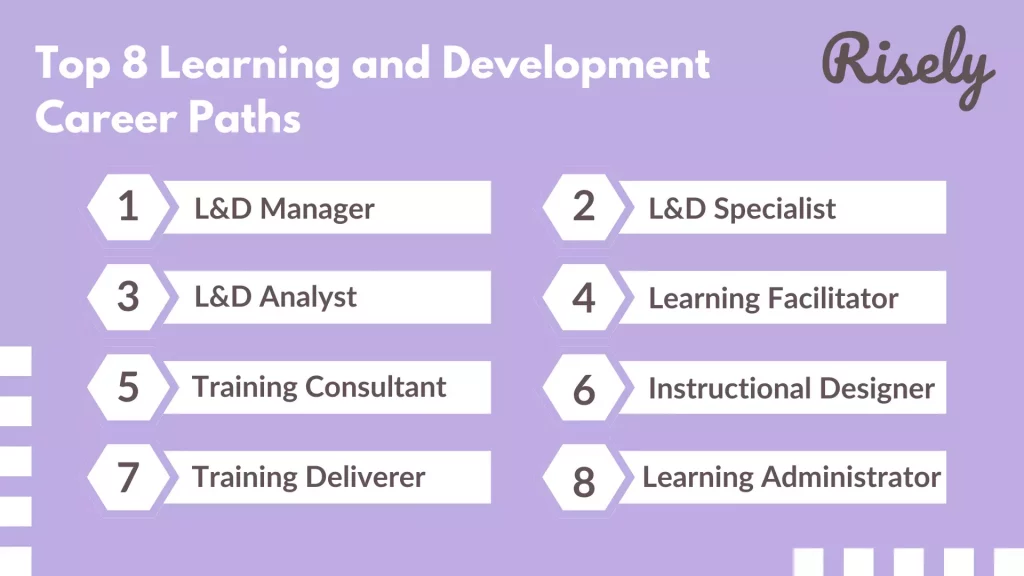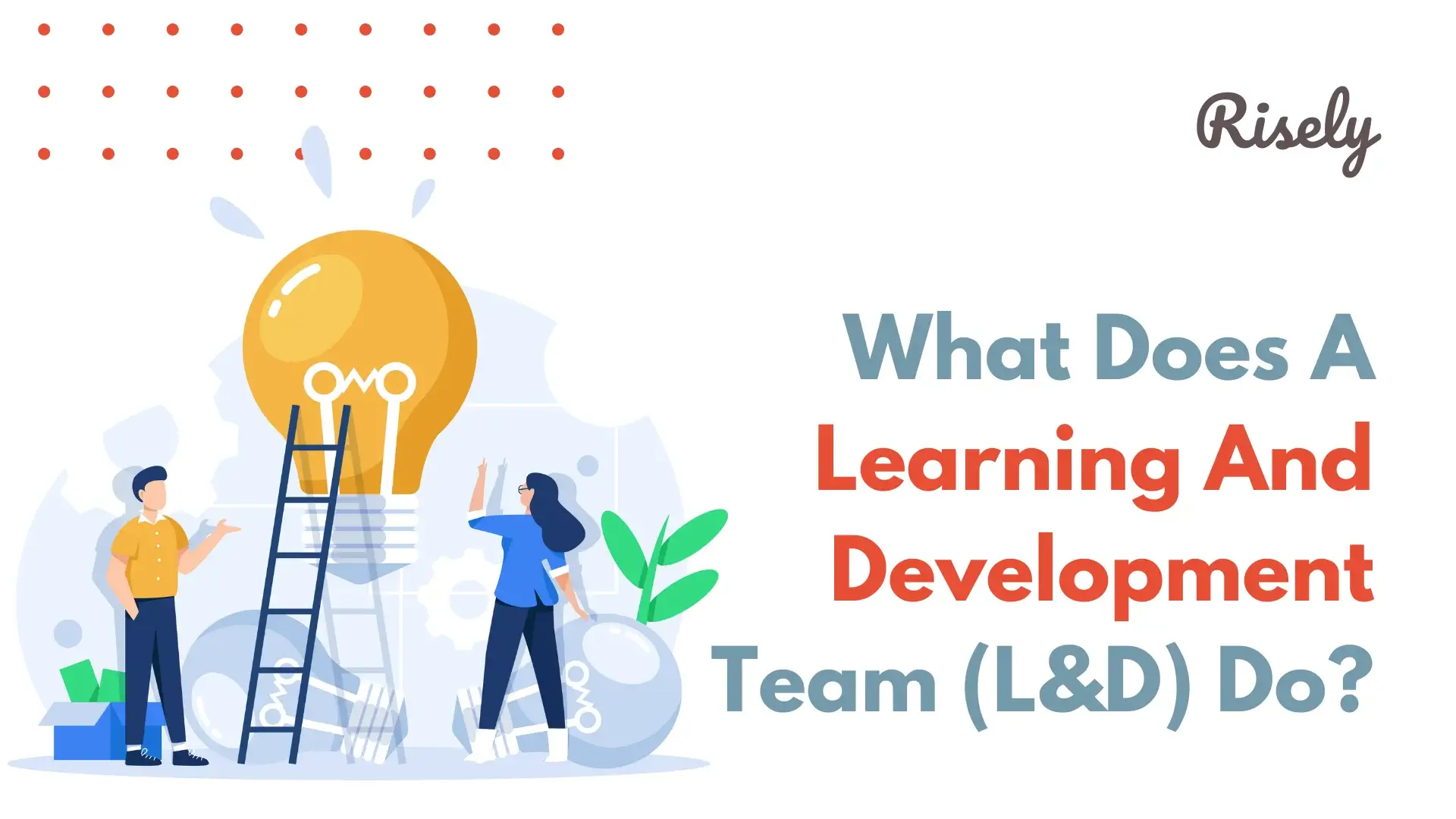Top 8 Learning And Development Career Paths: with Essential Skills To Succeed
Are you someone who believes in the power of continuous growth and learning? Do you enjoy helping others develop their skills and reach their full potential? If so, you’ve come to the right place! In this blog, we will explore Learning and Development career paths. Whether you’re a seasoned L&D professional seeking to advance your career or an aspiring learner eager to carve a path in this dynamic field, this blog is your ultimate guide. Join us as we delve into the roles, skills, and strategies to succeed in the L&D domain. Let’s explore!What is the Role of a Learning and Development Person?
A Learning and Development (L&D) professional plays a vital role in creating and implementing effective training programs to enhance employee knowledge, skills, and organizational performance. Their primary objective is to foster a continuous learning and growth culture among employees, ensuring they have the necessary tools and expertise to meet their job requirements and contribute to the company’s overall success. L&D personnel assess the learning needs of employees, design and develop training materials, and deliver engaging learning experiences through various mediums such as workshops, e-learning platforms, and instructor-led sessions. They collaborate closely with subject matter experts and department heads to identify gaps in knowledge and competencies, tailoring training initiatives to address them. By staying abreast of industry trends and best practices, L&D professionals contribute to the organization’s adaptability and competitive edge in a rapidly evolving business landscape.5 Essential Skills to Excel to Succeed in Learning and Development Career Paths
To succeed in learning and development career paths, developing the following essential skills is crucial:Instructional Design Expertise
Strong instructional design skills are at the core of a successful L&D career. This involves analyzing learning needs, designing effective training materials, and creating engaging learning experiences. Understanding adult learning principles, learning theories, and how to structure content for different learning styles are key components of instructional design expertise.Communication and Facilitation Skills
Effective communication is paramount for L&D professionals, as they need to convey complex information clearly and engagingly. Strong communication skills are essential when designing materials, delivering training sessions, or collaborating with stakeholders. Being a skilled facilitator also helps create an inclusive and interactive learning environment.Technology Proficiency
In the digital age, technology plays a significant role in L&D. Proficiency with learning management systems (LMS), e-learning authoring tools, and multimedia applications is essential for designing and delivering modern training solutions. Embracing technology allows L&D professionals to stay current with industry trends and enhance the overall learning experience.Analytical and Problem-Solving Abilities
L&D professionals need to gather data, analyze training effectiveness, and identify areas for improvement. Being able to interpret metrics and feedback helps refine training strategies and measure the impact of learning initiatives. Effective problem-solving skills enable L&D professionals to address challenges and adapt training approaches.Adaptability and Continuous Learning
The L&D field constantly evolves, with new technologies and methodologies emerging regularly. Being adaptable and open to change allows professionals to embrace innovative practices and stay ahead of the curve. Furthermore, a commitment to continuous learning is vital for staying updated with industry trends and enhancing personal and professional growth. By honing these essential skills, aspiring and current L&D professionals can position themselves for success in their learning and development career paths and significantly impact employee development and organizational growth.Top 8 Learning and Development Career Paths

L&D Manager
- Role and Responsibilities: L&D Managers oversee an organization’s learning and development function. They design and implement training strategies, manage L&D teams, collaborate with stakeholders, and ensure alignment with business goals.
- Skills Required: Strong leadership, communication, and project management skills. Business understanding and the ability to analyze training needs and measure the impact of training initiatives are also crucial.
- How to Get There: Typically, L&D Managers have several years of experience in L&D roles and have successfully designed and delivered effective training programs. Obtaining a relevant degree and pursuing professional development opportunities can strengthen your candidacy for managerial positions.
L&D Specialist
- Role and Responsibilities: L&D Specialists focus on a specific area within learning and development, such as e-learning, leadership development, or compliance training. They design and develop training content and assess the effectiveness of learning programs.
- Skills Required: Expertise in their specialized area, instructional design skills, and proficiency in using authoring tools and learning management systems.
- How to Get There: Start as an entry-level L&D professional or instructional designer, gain experience in your chosen area of specialization, and continuously enhance your skills through workshops and certifications.
L&D Analyst
- Role and Responsibilities: L&D Analysts use data and metrics to assess the impact and effectiveness of training initiatives. They gather insights, identify trends, and make data-driven recommendations for improving L&D strategies.
- Skills Required: Strong analytical and data interpretation skills, proficiency in data analysis tools, and an understanding of learning evaluation models.
- How to Get There: Begin as an L&D Coordinator or Training Administrator and focus on developing data analysis skills. Pursue courses in data analytics or business intelligence to enhance your qualifications.
Learning Facilitator
- Role and Responsibilities: Learning Facilitators deliver employee training sessions, workshops, and presentations. They engage learners, answer questions, and create an interactive learning environment.
- Skills Required: Excellent communication, presentation, and facilitation skills. A deep understanding of instructional techniques and adult learning principles is essential.
- How to Get There: Gain experience in training sessions as a Training Coordinator or Training Deliverer. Seek feedback and continuously improve your facilitation skills.
Training Consultant
- Role and Responsibilities: Training Consultants work externally or as part of an L&D firm. They advise organizations seeking to optimize training processes, develop learning strategies, and address specific training needs.
- Skills Required: Strong consulting, communication, and problem-solving skills. In-depth knowledge of L&D best practices and industry trends.
- How to Get There: Obtain significant experience in L&D roles, work with various clients on training projects, and build a strong reputation as a subject matter expert.
Instructional Designer
- Role and Responsibilities: Instructional Designers create effective and engaging training content. They collaborate with subject matter experts to design courses, develop learning materials, and incorporate multimedia elements.
- Skills Required: Proficiency in instructional design methodologies, creativity, and expertise in using authoring tools and multimedia software.
- How to Get There: Pursue a degree in instructional design or related fields. Build a strong portfolio showcasing your instructional design projects and continuously expand your knowledge of design principles.
Training Deliverer
- Role and Responsibilities: Training Deliverers conduct training sessions and workshops for employees. They ensure the effective transfer of knowledge and skill development among participants.
- Skills Required: Excellent presentation and communication skills, subject matter expertise, and the ability to engage learners.
- How to Get There: Start as a Learning Facilitator or Training Coordinator and gain experience delivering various training sessions. Seek feedback and continuously work on improving your training delivery techniques.
Learning Administrator
- Role and Responsibilities: Learning Administrators handle training programs’ logistics and administrative aspects. They manage training schedules, enrollments and handle training-related documentation.
- Skills Required: Strong organizational and administrative skills, attention to detail, and proficiency in learning management systems.
- How to Get There: Begin as a Training Coordinator or Administrative Assistant in an L&D department. Learn to use learning management systems and develop efficient organizational skills.
7 Practices to Succeed in Learning and Development Career Paths
Succeeding in learning and development career paths requires dedication, continuous improvement, and a commitment to personal and professional growth. Here are seven practices to help you excel in your learning and development career paths:- Embrace Continuous Learning: Stay updated with the latest trends, best practices, and emerging technologies in the L&D field. Engage in continuous learning through workshops, webinars, conferences, and online courses. Invest in professional development to enhance your skills and knowledge, ensuring you bring value to your organization.
- Cultivate Adaptability: The L&D landscape constantly evolves, with new challenges and opportunities arising. Embrace change and cultivate adaptability to stay agile and responsive in designing effective learning solutions that meet your organization’s and learners’ dynamic needs.
- Build Strong Communication Skills: Effective communication is crucial for success in L&D. Develop your ability to convey complex concepts clearly and engagingly in written and verbal communication. Active listening and empathy are essential to understand learners’ needs and create impactful training experiences.
- Collaborate and Network: L&D professionals often work with stakeholders, subject matter experts, and team members. Cultivate strong collaboration skills and build a network within the industry. Collaborating with others fosters creativity and enriches your understanding of different perspectives and approaches to learning.
- Measure and Demonstrate Impact: Demonstrate the effectiveness and impact of your training initiatives through data-driven metrics and assessments. Show how your L&D efforts contribute to improved employee performance and business outcomes, reinforcing the value of L&D within the organization.
- Develop Leadership and Management Skills: If you aim to advance into managerial roles, focus on developing your leadership and management abilities. Effective leadership is essential in guiding L&D teams, aligning training strategies with organizational goals, and fostering a learning culture.
- Seek Feedback and Continuous Improvement: Actively seek feedback from learners, peers, and managers to identify areas for improvement in your training programs and instructional design. Embrace a growth mindset, learn from successes and challenges, and continuously strive to enhance the quality and impact of your L&D initiatives.
Conclusion
Embarking on a learning and development career paths can lead to a fulfilling and impactful journey. As you navigate various roles and responsibilities, remember the importance of continuous learning, adaptability, and strong communication. Embrace collaboration and seek opportunities to demonstrate the positive impact of your training initiatives. You can position yourself for future growth by developing leadership and management skills. Your dedication to fostering a culture of learning and growth within organizations will empower employees and contribute to the long-term success of businesses. Stay passionate, committed, and open to growth, and you will thrive in the ever-evolving learning and development landscape. You can also sign up for Risely to take assistance to test your skills and train yourself to fill the skill gaps.Gain the skills to resolve conflicts like a pro as a first-time manager!
Take the free conflict management assessment to navigate challenging situations as a first-time manager.
FAQs
Is learning and development a good career?
Learning and development is a rewarding career that offers opportunities to empower others, contribute to organizational success, and stay at the forefront of continuous growth and improvement.
What is the scope of L&D?
The scope of L&D is vast, encompassing employee training, skill development, leadership programs, talent management, and fostering a culture of continuous learning to drive organizational success and growth.
What is career in training and development?
A career in training and development involves designing, delivering, and managing learning initiatives within organizations to enhance employee skills, performance, and overall professional growth.
Other Related Blogs
What Does A Learning And Development Team (L&D) Do?
What Does A Learning And Development Team (L&D) Do? The role of Learning and Development (L&D) teams is critical in fostering growth within organizations. Understanding the essence of L&D in…
7 Best Leadership Conference Themes & Free Resources [2024]
7 Best Leadership Conference Themes & Free Resources [2024] Leadership conferences are essential for organizations to develop their leaders, foster collaboration, and align their teams toward achieving their goals. As…
How To Build A Learning Culture At Work?
How To Build A Learning Culture At Work? Go back to the beginning of your career. Fresh out of college and looking at the prospect of your new fancy job…
Top 10 New Manager Skills That You Must Learn
Top 10 New Manager Skills That You Must Learn Congratulations on your promotion as a new manager! It’s a big transition and can be challenging. You may have been an…


